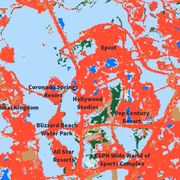A large destructive landslide occurred near Oso, Washington on March 22, 2014. Computer simulations indicate that it could have behaved very differently (with much less mobility and consequent destructiveness) if the ground had been less porous and water-saturated. This video shows the results of two computer simulations.
LCMAP Change Stories: Gone in 60 Seconds
Oso, Washington Landslide
At first glance, the most striking patterns in land cover change over time in this animation of the Oso, Washington area would appear to be forest harvest and regrowth, but a more dramatic change emerged in 2014.

The deep green that signals Tree Cover in the USGS Land Change Monitoring, Assessment, and Projection (LCMAP) Primary Land Cover product give way to the light tan of grass and shrubland from 1985-2017, only to be overtaken once again by green as trees regrow and mature.
But watch the end of the animation closely and you’ll notice another, more drastic change. On March 22, 2014, a 40 mile-per-hour landslide pushed 19 million tons of debris through the small residential development of Steelhead Haven in the space of a single minute.
This forest and small community at the base of the ridgeline near the North Fork Stillaguamish River were destroyed in the disaster, with the visible scar covering one-half square mile and causing temporary damming of the river.
The area remains mostly grassland/shrubland and has yet to return to its previous forested state, though 43 cedar trees were planted as a memorial to the 43 lives lost to the disaster.
Explore more LCMAP Change Stories by following the links below.
LCMAP Change Stories: Crops Give Way to Concrete LCMAP Change Stories: Crops Give Way to Concrete
LCMAP Change Stories: Building a Boomtown, Block by Block
LCMAP Change Stories: It's a Sprawl World After All
LCMAP Change Stories: Hurricanes in the Everglades
LCMAP Change Stories: Alabama Tornadoes
Below are multimedia items associated with this project.
A large destructive landslide occurred near Oso, Washington on March 22, 2014. Computer simulations indicate that it could have behaved very differently (with much less mobility and consequent destructiveness) if the ground had been less porous and water-saturated. This video shows the results of two computer simulations.
Below are publications associated with this project.
Hydroclimatic conditions preceding the March 2014 Oso landslide Hydroclimatic conditions preceding the March 2014 Oso landslide
Below are news stories associated with this project.
At first glance, the most striking patterns in land cover change over time in this animation of the Oso, Washington area would appear to be forest harvest and regrowth, but a more dramatic change emerged in 2014.

The deep green that signals Tree Cover in the USGS Land Change Monitoring, Assessment, and Projection (LCMAP) Primary Land Cover product give way to the light tan of grass and shrubland from 1985-2017, only to be overtaken once again by green as trees regrow and mature.
But watch the end of the animation closely and you’ll notice another, more drastic change. On March 22, 2014, a 40 mile-per-hour landslide pushed 19 million tons of debris through the small residential development of Steelhead Haven in the space of a single minute.
This forest and small community at the base of the ridgeline near the North Fork Stillaguamish River were destroyed in the disaster, with the visible scar covering one-half square mile and causing temporary damming of the river.
The area remains mostly grassland/shrubland and has yet to return to its previous forested state, though 43 cedar trees were planted as a memorial to the 43 lives lost to the disaster.
Explore more LCMAP Change Stories by following the links below.
LCMAP Change Stories: Crops Give Way to Concrete LCMAP Change Stories: Crops Give Way to Concrete
LCMAP Change Stories: Building a Boomtown, Block by Block
LCMAP Change Stories: It's a Sprawl World After All
LCMAP Change Stories: Hurricanes in the Everglades
LCMAP Change Stories: Alabama Tornadoes
Below are multimedia items associated with this project.
A large destructive landslide occurred near Oso, Washington on March 22, 2014. Computer simulations indicate that it could have behaved very differently (with much less mobility and consequent destructiveness) if the ground had been less porous and water-saturated. This video shows the results of two computer simulations.
A large destructive landslide occurred near Oso, Washington on March 22, 2014. Computer simulations indicate that it could have behaved very differently (with much less mobility and consequent destructiveness) if the ground had been less porous and water-saturated. This video shows the results of two computer simulations.
Below are publications associated with this project.
Hydroclimatic conditions preceding the March 2014 Oso landslide Hydroclimatic conditions preceding the March 2014 Oso landslide
Below are news stories associated with this project.







